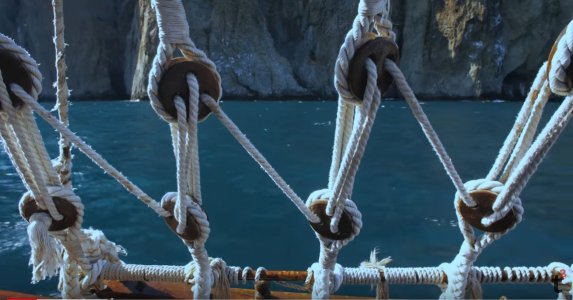As the old saying goes, different ships, different long splices. The lanyard needs plenty of extra length both for adjustment and for downrigging/uprigging. Since there are six passes of the line between the deadeyes, every inch of adjustment needs six inches of lanyard, and a surprising amount of lanyard can be needed to take up all the desired slack and stretch in the shroud, especially when the ship is new and the shrouds have not yet gone "dead", with all of the stretch taken out. There are lots of variations known from the historical record (and even a few archaeological examples) in how the lanyard is made off and what to do with the extra length. The solution shown on l'Hermione could be one of them, or it could be a modern solution (there are a lot more of those among working vessels than most people realize; sailing ships, even traditional ones, is a constantly evolving process). I know one of the people who rigged the ship, and they were constantly working the balance between historical authenticity (where it could be determined), practicality, and the needs of modern seaworthiness standards. And, as one person alluded to, the captain gets what the captain wants (a long-standing tradition in the rigging department, especially in respect to largely aesthetic details).
As an aside, I am afraid I have to defend my profession here. Jim wrote: "I get a bit sceptical of the experimental archaeologists? who can barely use a tool coming up with elaborate ideas when anyone used to doing real work can say why a ‘something’ is the way it is - because when you do the job every day you make it as easy as possible." As a professional experimental archaeologist, I think I know what Jim is referring to, but the people who do not know which end of a hammer you hold are not the experimental archaeologists (most of us have professional backgrounds in technical trades; I was a wooden shipwright and a machinist) but the theoretical archaeologists, who often come up with the most convoluted explanations for simple things while sitting in air-conditioned offices.
Experimental archaeologists are the people who figured out how to tack a Viking ship, or why the most important variable in the lethality of cannon fire against ships is not the velocity of the projectile but the thickness of the target (thinner is better!). Archaeologists are, for the most part, practical people. We work in the field, doing manual labour (digging holes...), and we understand the world through our hands. On underwater projects, we have to keep engines, pumps and compressors running in harsh environments (I once hand-filed a high-pressure valve seal out of a kitchen knife blade). In Jim's terms, we do the job every day and have to figure out how to do it efficiently and safely.
Fred









